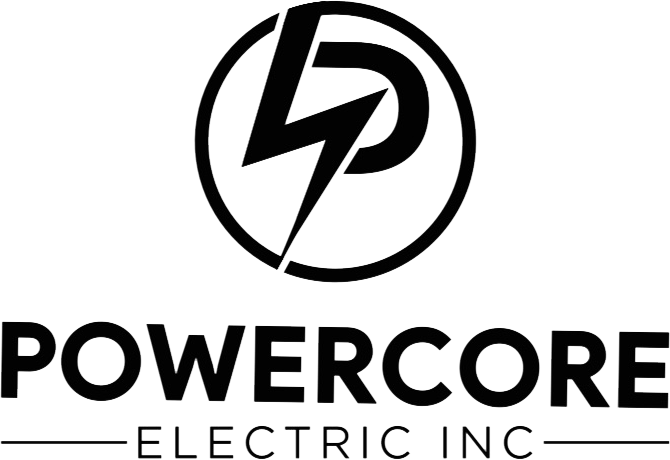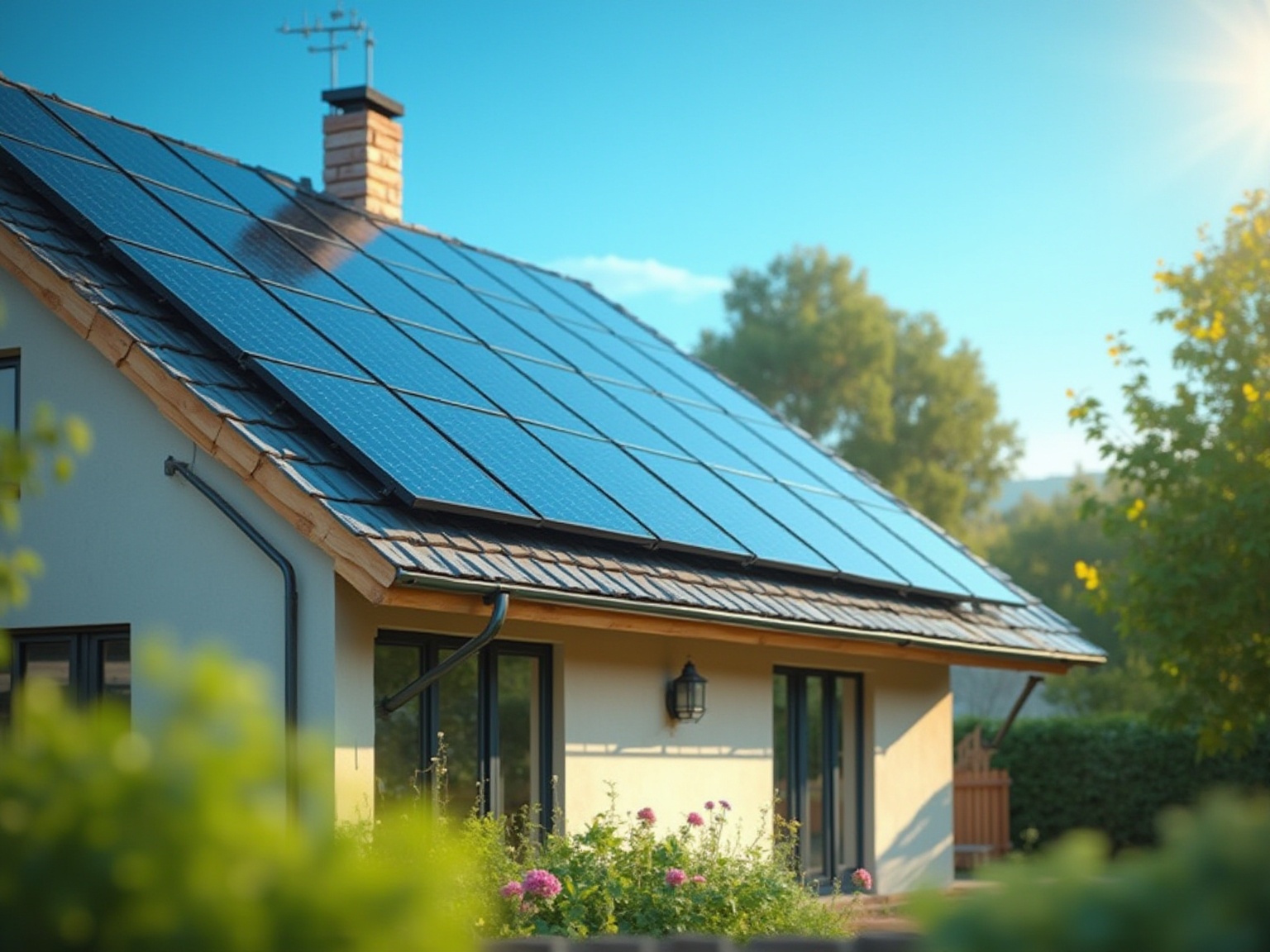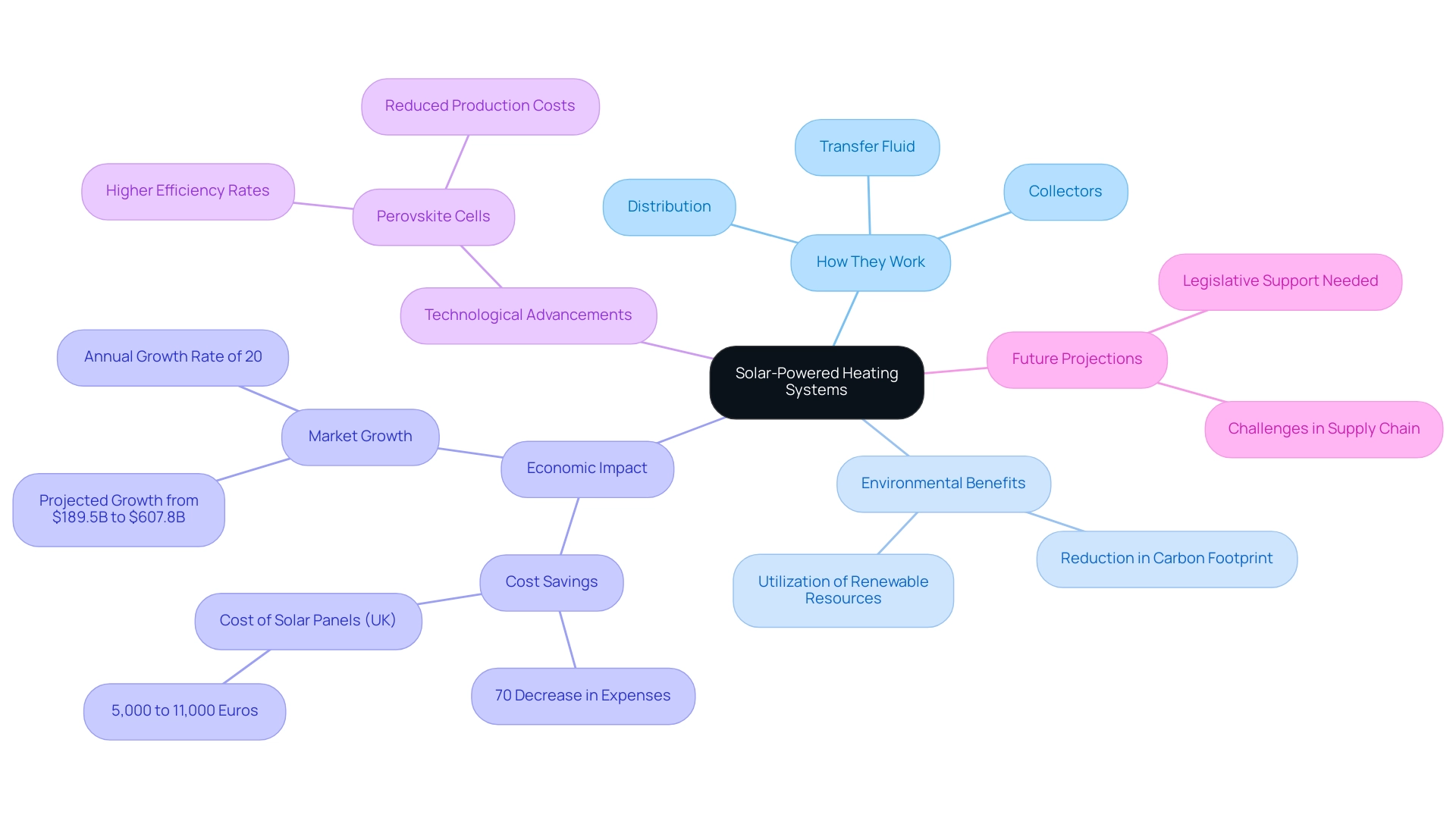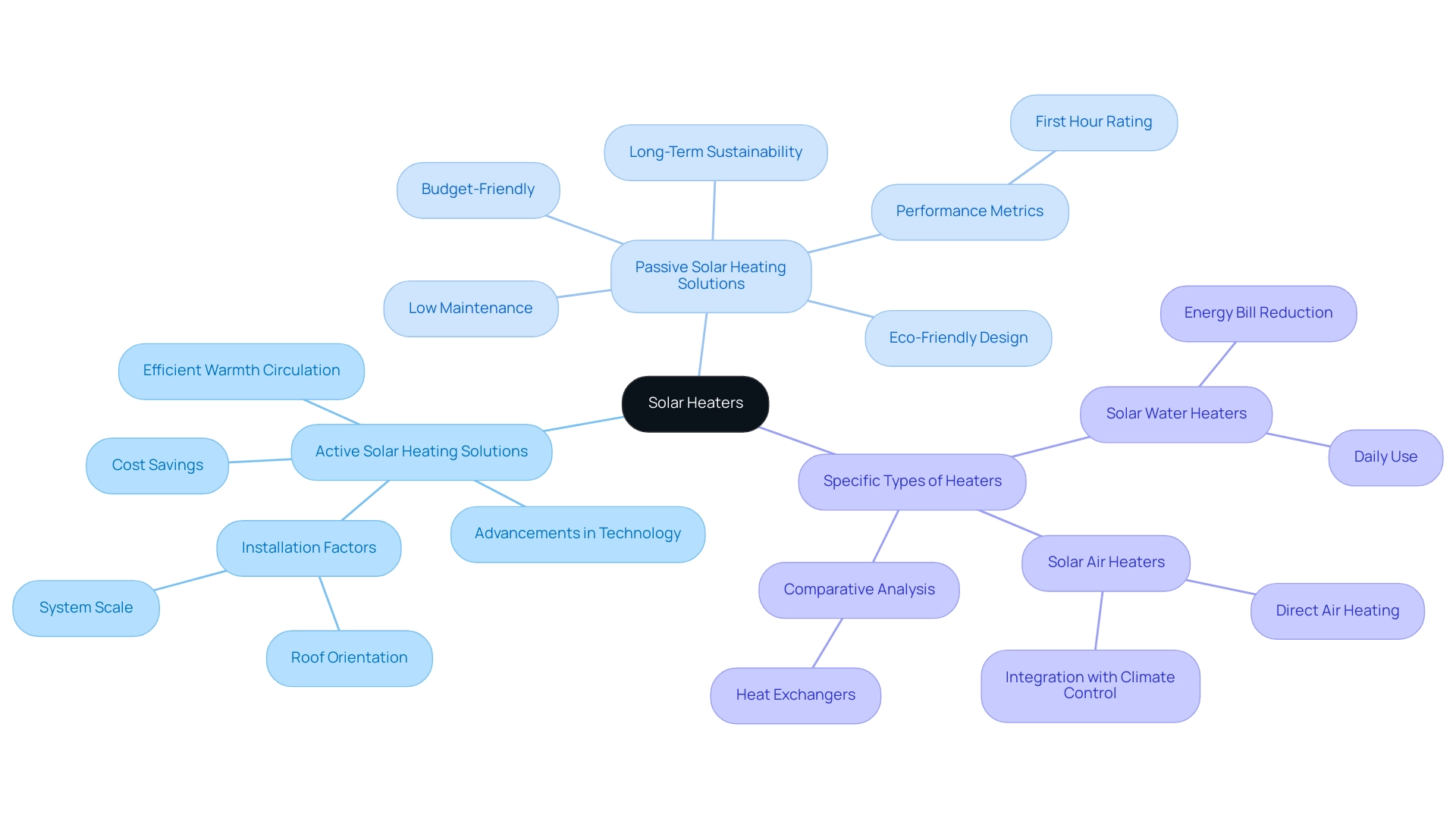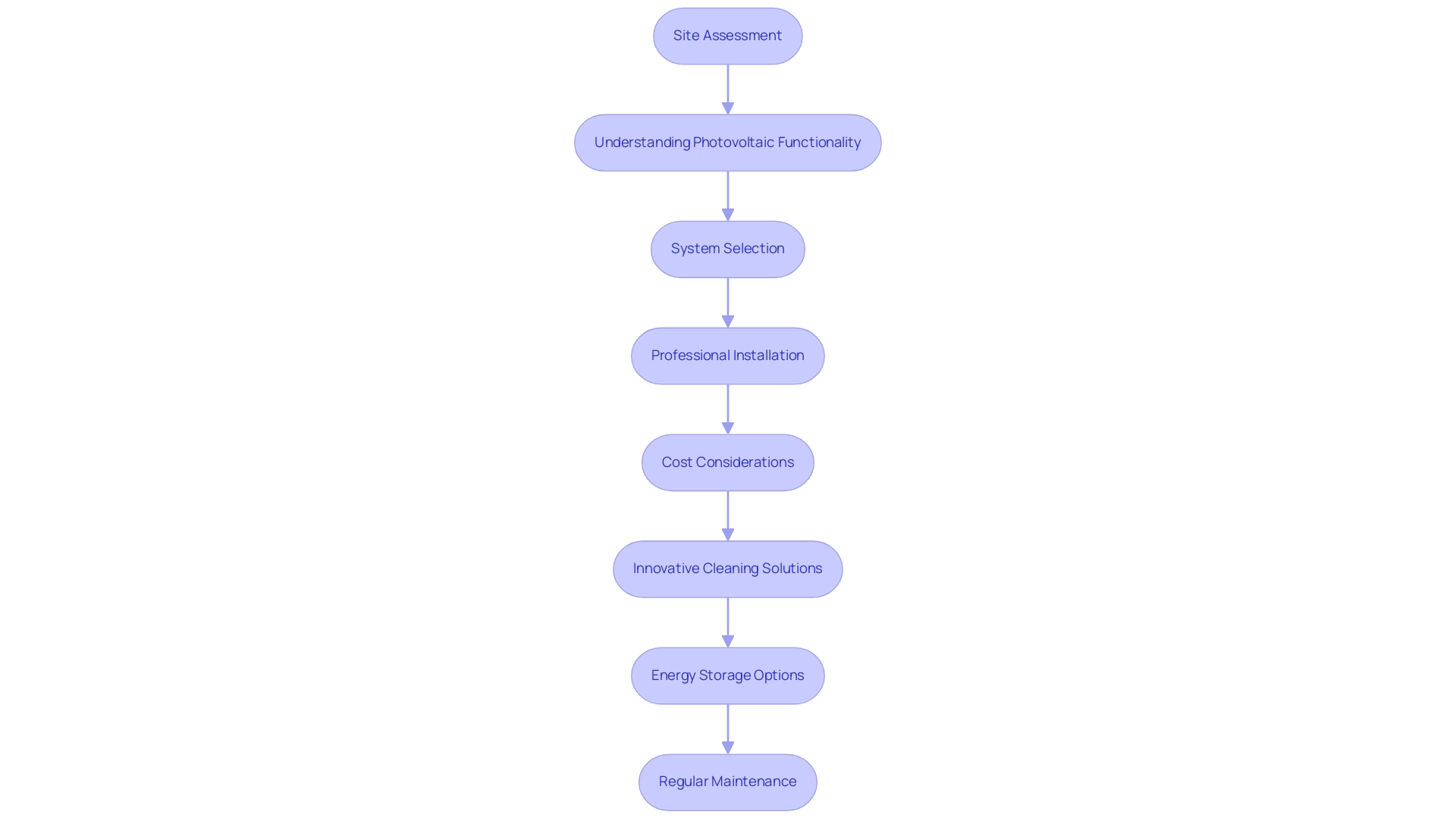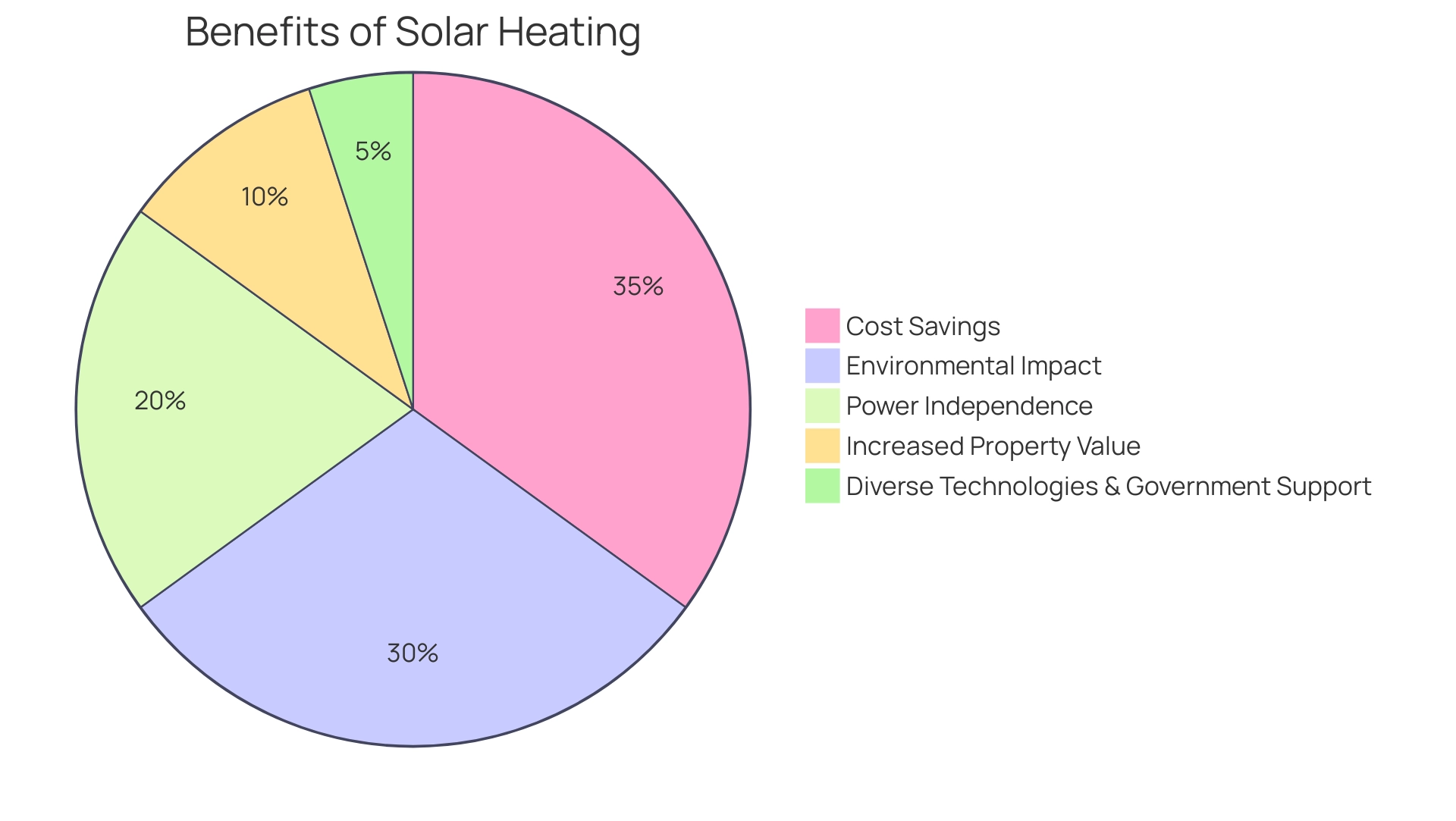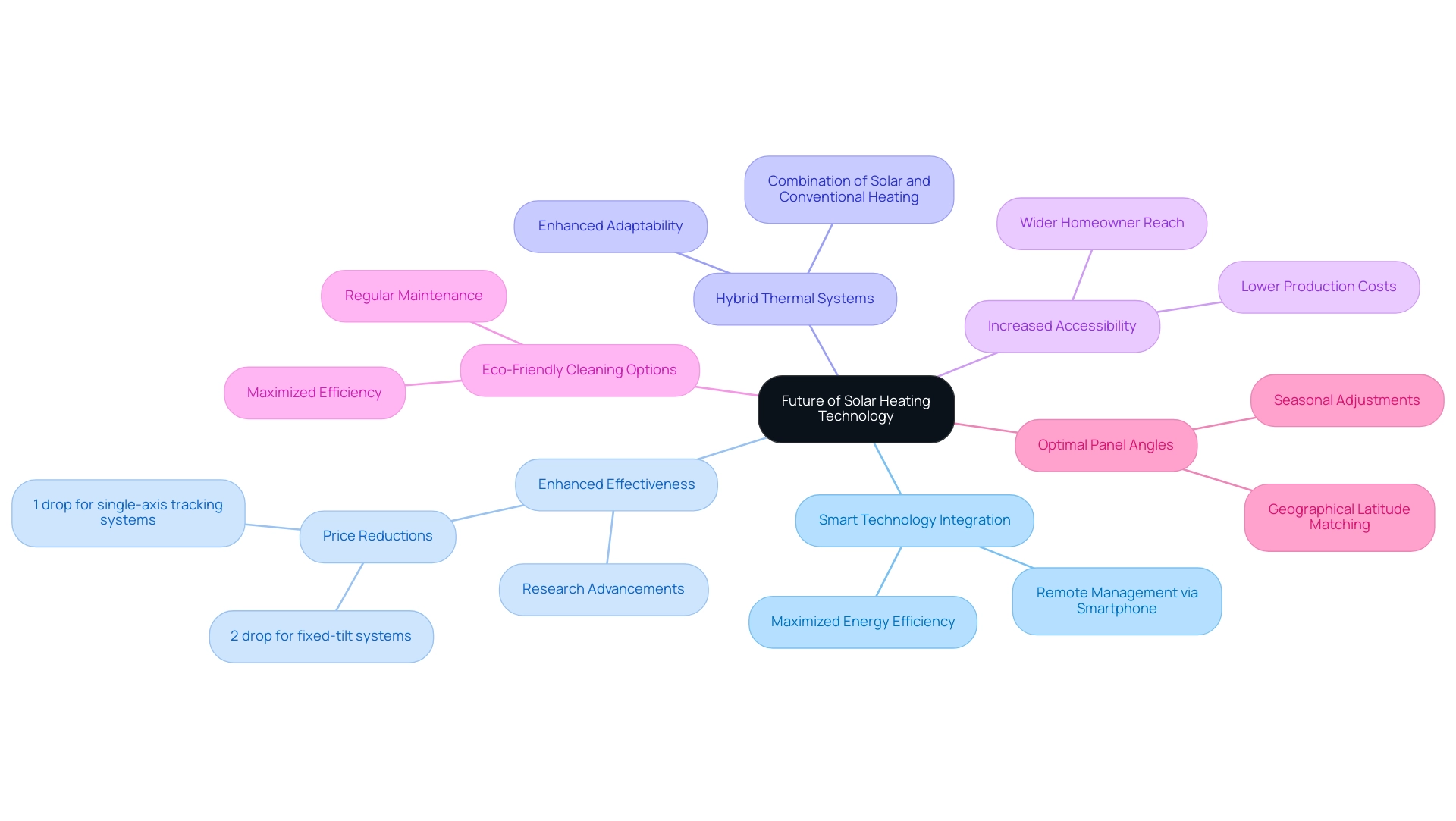Overview
Heaters that run on solar power provide an eco-friendly and cost-effective heating solution for homeowners by harnessing sunlight to generate warmth, significantly reducing energy costs and carbon footprints. The article emphasizes that understanding the types of solar heaters, along with proper installation and maintenance, is crucial for maximizing their efficiency and benefits, as evidenced by case studies showing substantial savings and the growing popularity of renewable energy technologies.
Introduction
In a world increasingly focused on sustainability and energy efficiency, solar-powered heating systems are emerging as a game-changer for homeowners. These innovative solutions harness the sun’s energy, offering not only a warm and cozy home but also significant savings on energy bills.
With options ranging from active and passive solar heating systems to specialized solar water and air heaters, there’s a perfect fit for every household. As technology continues to advance, understanding how these systems work and their myriad benefits can empower homeowners to make informed decisions.
From cutting costs to reducing carbon footprints, the journey into solar heating is not just about embracing a trend; it’s about paving the way for a more sustainable future. Join the growing community of eco-conscious homeowners who are discovering the transformative power of solar energy.
Understanding Solar-Powered Heating Systems
Heaters that run on solar power are excellent warming solutions for homeowners seeking to harness the sun’s power to maintain their environments warm and comfortable. These setups operate by utilizing collectors to capture sunlight, which then heats a transfer fluid that circulates and distributes warmth throughout your home. In contrast to conventional farming methods that frequently rely on fossil fuels or grid electricity, these heaters harness renewable resources, making them an eco-friendly option.
Not only do they help reduce your carbon footprint, but they can also result in impressive savings over time. In reality, several case studies emphasize the effectiveness of these systems, demonstrating that residences in Southern California have attained over a 70% decrease in expenses by adopting heaters that run on solar power. Additionally, the efficiency of photovoltaic panels can be maximized by installing them at the optimal angle, which varies based on regional climate conditions.
This is essential for homeowners in regions like Palo Alto, where advancements in technology, such as perovskite cells, are improving energy solutions. Perovskite cells provide higher efficiency rates and reduced production costs, making them a promising choice for future energy applications. However, the renewable energy sector faces challenges, including supply chain issues and the need for legislative support to enhance deployment, as highlighted by industry experts.
According to recent trends, the global renewable energy sector is expected to grow significantly, projected to increase from $189.5 billion in 2022 to a staggering $607.8 billion by 2030, with a robust annual growth rate of 20%. This shift reflects the increasing popularity and adoption of renewable energy technology in homes. A case study on the expense of photovoltaic panels in the UK reveals that prices range from 5,000 to 11,000 Euros, illustrating the financial implications of adopting renewable energy solutions.
Understanding how heaters that run on solar power function is crucial for selecting the appropriate system for your needs and can lead to a more sustainable and economical future. As policy analyst Ben Zientara aptly puts it, ‘We have all the technology we need to do this today, but we need help from state and federal legislators and regulators to deploy, deploy, deploy.’ This emphasizes the significance of not only technology but also supportive policies in promoting energy adoption.
Furthermore, the recent Reviews report on the best panel brands for 2024 underscores the importance of selecting quality products in this evolving market.
Exploring Different Types of Solar Heaters
When evaluating warmth alternatives for your home that are based on sunlight, it’s crucial to investigate the different kinds of heaters that run on solar power available. With global solar PV investments in capacity additions exceeding USD 480 billion in 2023, the significance of solar thermal solutions has never been clearer. Here’s a friendly breakdown of the benefits of heaters that run on solar power.
-
Active Solar Heating Solutions: These setups feature heaters that run on solar power, utilizing pumps and fans to circulate warmth, making them highly effective for warming both water and air. If your residence has high warmth requirements, heaters that run on solar power are an excellent option, ensuring you remain comfortable during colder months. Experts highlight that advancements in active heating technology are leading to even greater efficiency and reliability, ultimately contributing to significant cost savings and greenhouse gas reductions.
Additionally, installation factors such as roof orientation and scale are crucial for maximizing performance.
-
Passive Solar Heating Solutions: Relying on smart building design and materials, these methods utilize heaters that run on solar power to naturally collect and distribute solar heat. They’re not just eco-friendly; heaters that run on solar power are also budget-friendly, requiring less maintenance and offering seamless integration into your home’s architecture.
This method not only lowers costs but also promotes long-term sustainability. Performance evaluation through metrics like the First Hour Rating can help you understand how well heaters that run on solar power will satisfy your hot water needs.
-
Heaters that run on solar power: Specifically crafted to heat water for everyday use, these heaters that run on solar power can significantly slash your energy bills.
Major players in the market, such as Azure Power India and Emmvee Solar Systems, are leading the charge in this area, providing innovative solutions. Imagine enjoying hot water for bathing, cooking, and cleaning without the hefty costs associated with traditional warming methods by using heaters that run on solar power, contributing to both economic and environmental benefits. Real-life case studies show that homeowners can achieve substantial savings and reduced carbon footprints by adopting heaters that run on solar power.
Heaters that run on solar power, such as Solar Air Heaters, warm air directly and can be easily integrated into your current climate control setup. Especially advantageous for space warmth in cooler regions, heaters that run on solar power can improve your home’s overall efficiency, decreasing your dependence on traditional warming techniques. A comparative analysis with heat exchangers can further illustrate how these technologies can work together for optimal home heating.
Each type of heater, such as heaters that run on solar power, offers distinct advantages that cater to different needs. By comprehending these choices, you can choose the appropriate heating solution that aligns perfectly with your home and lifestyle, ensuring fair access to sustainable power alternatives.
Installation and Maintenance of Solar Heaters
Establishing heaters that run on solar power is not merely a fulfilling venture; it’s a crucial move toward improving your home’s resource efficiency and sustainability. Here’s a friendly step-by-step guide to help you through the process:
-
Site Assessment: Start by evaluating your property.
Look for the best spot to place your energy collectors, keeping in mind factors like sunlight exposure and potential shading from trees or buildings. A well-placed system can significantly boost efficiency and energy production.
-
Understanding Photovoltaic Functionality: Before installation, it’s important to understand how panels work.
Solar panels convert sunlight into electricity, which can be used to power your home or charge batteries. This electricity can also be utilized to heat water, making it essential for heaters that run on solar power.
System Selection: Next, choose the right type of heaters that run on solar power to meet your heating needs and budget.
Whether you choose an active setup that uses pumps and controls or a simpler passive option, ensure it aligns with your energy goals. Remember, for optimal performance, your electrical panel should be at least 200 amps to support the installation.
Professional Installation: While the DIY route might be tempting, enlisting a professional for installation is a smart move.
Experts ensure that everything is set up correctly and safely, which is crucial for maximizing efficiency and longevity. As Emily Walker wisely suggests,
If you want to reduce your initial expense for renewable energy panels, consider financing your installation.
This option can ease initial expenses while ensuring a proper setup.
-
Cost Considerations: When choosing a water warming model, assess the extra expense of a more efficient system compared to the yearly operating cost savings.
This calculation can assist you in figuring out the payback period for your investment in heaters that run on solar power, making the economic advantages of heating from the sun clearer.
-
Innovative Cleaning Solutions: Regular maintenance is key to long-lasting performance.
Consider using eco-friendly cleaning solutions specifically designed for photovoltaic panels to enhance efficiency. Schedule annual inspections to check for leaks, clean the collectors, and ensure all parts are functioning smoothly.
-
Energy Storage Options: To maximize the advantages of your photovoltaic setup, consider investing in energy storage batteries.
These batteries store excess energy generated during the day for use at night or during cloudy weather, ensuring a consistent energy supply.
-
Regular Maintenance: Don’t forget about maintenance!
Simple tasks like cleaning the panels and monitoring fluid levels in active systems can be tackled on your own, but having a professional take a look yearly can make a big difference.
Cost Calculation Steps: To assist in making informed choices regarding your investment in renewable energy, consider following a structured approach like the five-step process outlined in relevant case studies on panel cost calculation.
This will assist you in evaluating the expenses related to installing photovoltaic panels, considering various personal and environmental factors.
By adhering to these steps, you’ll ensure that heaters that run on solar power operate efficiently and effectively for many years, contributing to both your home’s comfort and the environment. Additionally, as a Long Beach tenant, obtaining renewable solutions has never been simpler, in line with the environmentally friendly alternatives we all aim for!
Benefits of Solar Heating: Cost Savings and Environmental Impact
Investing in renewable energy systems provides numerous advantages for homeowners seeking to create a positive impact. Here’s a closer look at what you can expect:
- Cost Savings: By utilizing the benefits of free sunlight, numerous homeowners have noted significant reductions in their warming expenses, particularly with heaters that run on solar power, often up to 50%. This significant reduction not only eases monthly expenses but also helps families allocate funds to other important areas. As observed in several case studies, one household in Southern California faced a remarkable 70% reduction in their energy costs after adopting a water warming solution combined with a heat exchanger. According to recent studies, the global photovoltaic sector is anticipated to expand from $189.5 billion in 2022 to $607.8 billion by 2030, emphasizing the rising significance and investment opportunities in thermal energy solutions.
- Environmental Impact: One of the standout advantages of solar heating systems is their ability to operate without producing greenhouse gas emissions. This means a direct contribution to lowering your carbon footprint and protecting our planet for future generations. For example, heaters that run on solar power can reduce a household’s carbon output by 20 to 40 percent and decrease monthly utility costs by 30 percent. As Ben Zientara, a Solar Policy Analyst, observes, “The 2024 report is our second annual publication, utilizing data from our survey about installer-preferred brands and featuring new data about stateside manufacturing capacity,” which highlights the increasing emphasis on sustainable power solutions.
- Power Independence: Utilizing solar power, such as heaters that run on solar power, empowers you to reduce reliance on fossil fuels and conventional grid electricity. This shift not only enhances your control over power usage but also promotes a more resilient home in the face of potential shortages. In fact, a recent case study indicated that homeowners are increasingly installing batteries for backup power rather than financial savings, demonstrating a shift in consumer priorities towards power security.
- Increased Property Value: Homes equipped with renewable energy systems frequently experience an increase in resale value. Potential buyers are increasingly attracted to properties that include sustainable power solutions, making this investment not just a practical choice but a financially savvy one as well.
- Diverse Technologies and Government Support: Various thermal collection technologies, including passive power collection designs, can further enhance your home’s efficiency. Government initiatives and incentives are also accessible to help homeowners in embracing these technologies, facilitating the shift to renewable energy. These benefits collectively enhance your home’s comfort while paving the way for a more sustainable and secure future.
The Future of Solar Heating Technology
The solar heating industry is on an exciting trajectory, with several noteworthy trends shaping the future that every eco-conscious homeowner should know about:
- Smart Technology Integration: Imagine managing your solar warmth setup directly from your smartphone! Upcoming solutions will integrate intelligent technology, enabling you to oversee and modify your temperature remotely via accessible mobile applications. This innovation not only improves convenience but also maximizes energy efficiency, ensuring you get the most out of your setup.
- Enhanced Effectiveness: Ongoing research is expanding the limits of collectors and warming solutions, striving for even greater efficiency and reduced expenses. For instance, utility-scale system pricing has dropped by 2% for fixed-tilt and 1% for single-axis tracking year-over-year. Such advancements promise better performance, making heaters that run on solar power an increasingly appealing option for homeowners seeking sun-based warmth.
- The emergence of hybrid thermal systems—utilizing heaters that run on solar power along with conventional warming techniques—provides a transformative solution. This mixture offers enhanced adaptability and dependability, guaranteeing uniform warmth even when sunlight generation decreases.
- Increased Accessibility: As technology advances and production expenses decrease, heating systems are becoming more affordable and reachable for a wider variety of homeowners. This shift means that more families can invest in affordable heaters that run on solar power as sustainable energy solutions. As Ben Zientara, a Policy Analyst for renewable energy, aptly notes, “we have all the technology we need to do this today, but we need help from state and federal legislators and regulators to deploy, deploy, deploy.”
- Eco-Friendly Cleaning Options: To maintain optimal performance, consider eco-friendly cleaning solutions for your photovoltaic panels. Regular cleaning helps ensure that dust and debris do not hinder absorption, maximizing efficiency and extending the lifespan of your system.
- Optimal Panel Angles: Determining the best angle for your solar panels is crucial for maximizing output. Ideally, panels should be tilted at an angle that matches your geographical latitude to capture the most sunlight throughout the year. Adjusting the angle seasonally can further enhance power generation.
Staying informed about these exciting developments will empower you to make informed decisions about your home and energy needs. With 54% of installers expecting increased sales in 2024 and 34% of energy companies anticipating growth, there’s a palpable sense of optimism in the air, suggesting that now is the perfect time to explore heating options that suit your lifestyle. This optimism is further supported by the case study titled “Optimism for 2024 in the Solar Industry,” which highlights the positive outlook among solar companies despite the challenges faced in 2023.
Conclusion
Embracing solar-powered heating systems is a transformative step for homeowners eager to enhance their energy efficiency and sustainability. By understanding the mechanics of these systems, from active and passive solar heaters to solar water and air heaters, homeowners can make informed decisions that align with their needs and lifestyles. The potential for significant cost savings—often up to 70%—and the reduction of carbon footprints underscore the practical and environmental advantages of solar heating.
As technology continues to advance, the future of solar heating is bright, with innovations such as smart technology integration and hybrid systems on the horizon. These developments promise not only increased efficiency but also greater accessibility for families looking to invest in sustainable energy solutions. With government support and growing market trends, transitioning to solar heating is not just a possibility; it’s becoming an increasingly attainable reality.
Ultimately, the journey towards solar heating is about more than just lowering energy bills; it’s about contributing to a healthier planet and ensuring energy independence. By joining the movement towards renewable energy, homeowners are not only enhancing their own living spaces but also paving the way for a sustainable future for all. The time to act is now, and the rewards are plentiful.
